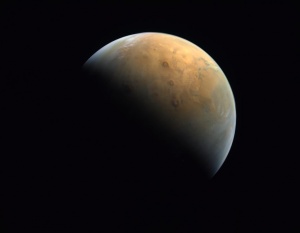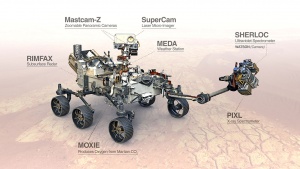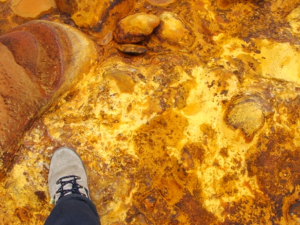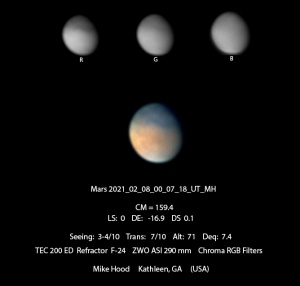All Eyes on Mars
Three missions are converging on Mars this week to study the Red Planet from orbit and explore its surface. With the United States, United Arab Emirates and China all sending missions to Mars, we look at how Europe’s planetary research community is contributing to Mars exploration in 2021 and at its plans for the next few years.

It’s a busy time at Mars. The United Arab Emirates (UAE) Space Agency’s first mission to Mars, Hope, performed a successful manoeuvre to enter a capture orbit on 9 February 2021. Once in its final science orbit, Hope will study dynamics in the martian atmosphere on a global scale, giving a more complete understanding of interactions between the atmospheric layers, and answering questions about how oxygen and hydrogen escape into space.
On 10 February, the Chinese Tianwen-1 (‘questioning the heavens’) mission, joined Hope in orbit around Mars. Tianwen-1 will analyse the chemical composition of rock and dust and search for pockets of ice and liquid water and organics. Following three or four months of study of the surface, and a detailed survey of the proposed landing site, Tianwen-1 will release a lander and rover. If all goes to plan, the rover will explore Utopia Planitia, a flat plain within a large impact basin in the northern hemisphere of Mars. The region is covered by extensive sedimentary materials, with features that indicate that ice or water are present.
Tianwen-1 carries 13 instruments, two of which have a small European involvement: The Institut de Recherche en Astrophysique et Planétologie (IRAP), France, has contributed to the calibration of the LIBS spectrometer on the Tianwen-1 rover’s Mars Surface Composition Detector. The Space Research Institute (IWF-Graz) has contributed to the calibration of the magnetometer on the main satellite.
Completing the trio, NASA’s Mars 2020 mission will arrive at Mars on 18 February. Mars 2020 mission will look for signs that there were habitable conditions on Mars in its early geological history, and seek evidence of past microbial life. The Perseverance rover and its helicopter partner, Ingenuity, will explore the terrain of Jezero Crater on Mars, which contains the remains of an ancient, partially-eroded river-delta. Jezero’s rocks date back to around the time that we think that life first arose on Earth. Perseverance will characterise its geological setting and collect a few core samples of the most promising rocks and soils. These will be set aside in a cache for collection and return to Earth by missions later this decade.

Of the seven primary scientific instruments carried by the Perseverance rover, three include significant European contributions: the weather station MEDA (provided by Spain with contributions from Finland), the remote-sensing laser micro-imaging SuperCam (provided by France/Spain) and the ground-penetrating radar RIMFAX (provided by Norway).
Although not part of the flotilla arriving at Mars this year, the ESA/Roscosmos ExoMars mission will set off in the late summer or autumn of 2022 and land in the spring of 2023. The ExoMars Rosalind Franklin Rover is equipped with a drill that will sample the subsurface in places that are most likely to have habitable conditions preserved in ancient rocks.
The first ExoMars mission, the Trace Gas Orbiter (TGO), which arrived at Mars in 2016, carries a suite of instruments to study traces of methane and other atmospheric gases. TGO will also act as a data relay for Perseverance (a service it already provides for the Curiosity and Insight missions) and, later, for the ExoMars Rosalind Franklin rover. ESA’s highly successful first mission to the Red Planet, Mars Express, which has been in orbit since 2003 and is still making important contributions to studies of the martian surface, atmosphere and ionosphere, is also playing a part in monitoring local conditions at Jezero Crater.
To find out more about Europe’s contribution to Mars missions, watch this EPSC2020 Session Showcase TP16 – European Exploration of Mars: From Mars Express to ExoMars and Beyond:
Europlanet 2024 RI and Mars Exploration
The Europlanet 2024 Research Infrastructure (RI) Transnational Access field sites (TA1) include terrestrial analogues that are relevant to both the areas of Mars that will be explored by Tianwen-1 and Perseverance. Terrestrial analogues play a vital role in understanding where and how life exists under extreme conditions on Earth, such as in hydrothermal systems in Iceland and Ethiopia’s Danakil Depression, extreme acidic conditions at Rio Tinto in Spain and extreme salty conditions at Danakil’s Dallol volcano and the Makgadikgadi Salt Pans in Botswana. In turn, this informs the mission teams searching to identify where life might have arisen on Mars.
Europlanet 2024 RI’s TA2 laboratory facilities also support the exploration and the search for biomarkers on Mars. The Centre for Microbial Life Detection in Graz provides expertise in extracting and sequencing DNA from microbial samples collected in extreme environments on Earth, as well as quantifying bacteria, archaea and fungi, and cultivating specialist microbes (e.g. anaerobes) that survive under these conditions.
Simulations and calibration measurements carried out at the spectroscopy laboratories at DLR and Grenoble will be used to interpret the spectroscopic data obtained by the Tianwen-1 orbiter. The Aarhus Mars Wind Tunnel and Open University’s Mars Chamber also include facilities capable of simulating Martian atmospheric conditions.
Early life on Mars may have been destroyed after the loss of its atmosphere, which provided a shield against harmful ultraviolet radiation. This means that finding evidence for past life may be through indirect means, for example by identifying chemical changes to minerals or specific reactions that are only induced by life. Samples taken from terrestrial analogues and analysed in laboratories can help interpret data from in-situ missions and refine techniques. However, within the limitations of what it is possible to launch into space, it is likely to be difficult for robotic missions operating on the surface of Mars to provide conclusive evidence of whether life has ever existed there.

NASA and ESA are collaborating on a Mars Sample Return campaign involving three missions stages: a sample collection rover (Perseverance); a Mars lander carrying a small ESA-led rover to ‘fetch’ and load the samples into NASA’s ‘Mars Ascent Vehicle’ that will launch them into Mars orbit; and a Mars orbiter to capture the sample container (led by NASA) and fly it the rest of the way to Earth (led by ESA).
The samples collected by Perseverance will contain martian rocks, soil, dust and atmosphere and are expected to be about 15 g of material each and be roughly the size of a stick of chalk. Bringing carefully selected rocks from Mars back to Earth for detailed study will enable much more complex and complete studies using state-of-the-art lab equipment. This will give a better quantitative understanding of whether the returned samples formed in environments where life could have existed and whether they may contain biosignatures
Europlanet 2024 RI Joint Research Activities (JRAs) involving the Natural History Museum, the Vrije Universiteit Amsterdam, ETH Zurich and the Open University are supporting the development of techniques for non-destructive or minimally invasive characterisation and analysis of precious returned samples.
Europlanet 2024 RI is also offering virtual services to support observations and analysis.
A successful landing depends heavily on site selection and characterisation, tasks that are strongly tied to geologic mapping. Europlanet 2024 RI’s new geological mapping service, GMAP, fosters and supports mapping of the geology of all suitable Solar System bodies. In the case of the Moon and Mars this will include specific geologic and geomorphic mapping of past, proposed and future landing sites.
The virtual observatory for Solar System data, VESPA, hosts several data services from past Mars missions, including Mars-Express (OMEGA, HRSC, SPICAM), CRISM data from Mars Reconnaissance Orbiter, a Martian craters database, simulated atmospheric profiles (derived from the Mars Climate Database), Hubble Space Telescope observations, significant data about the magnetosphere, as well as access to the Planetary Science Archive (PSA).

VESPA tutorials support researchers in working with the data, for example to compare measured and simulated profiles in the martian atmosphere or in plasma data, to analyse spectral cubes or to identify overlapping datasets in surface maps and images.
The Planetary Virtual Observatory and Laboratory (PVOL) data service includes nearly 4000 observations of Mars contributed by amateur astronomers, which are used for research purposes by several professional and amateur teams.
Finally, Europlanet is developing educational resources that draw on missions and the latest research in laboratories and field sites to bring Mars into classrooms across Europe. Those students inspired by the missions in 2021 may one day have the opportunity to handle and analyse the samples collected and brought back from Mars by future missions.

